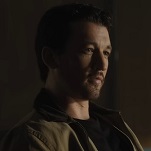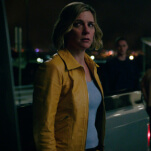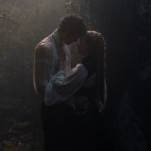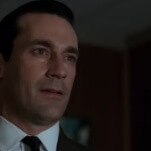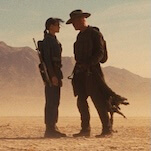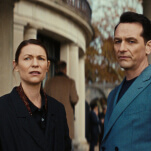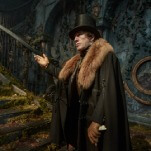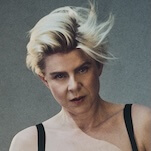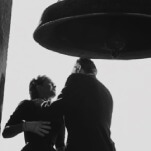While the second episode of Cloak & Dagger ended on one hell of an exciting twist, the rest of it was an unpleasant exercise in watching people be terrible to its two likable leads. With the exception of their respective love interests, Tandy and Tyrone endured a lot of cruelty. Luckily, episode three is here to change things.
“Stained Glass” isn’t just a marked improvement in storytelling for the series (though admittedly, Evita’s voodoo tour group sequence went on way too long). It’s an exciting demonstration of Cloak & Dagger embracing unconventional narratives and imagery in place of more traditional formats. The first two episodes showed potential, but felt like generic storytelling in search of something better. Now, three episodes into its run, the show is staking out an ambitious and fascinating path with the kind of episode most series wait far longer to try, a strong sign of confidence from the writers. The first couple of episodes gave us flashbacks, but here, the entire episode pivots around a lengthy dream sequence—technically two of them, but they run together in interesting ways—and a closer look at these hallucinatory scenes shows why the Marvel series has potential.
A quick recap: Tyrone enters the voodoo-inspired bath and finds himself in an empty and washed-out dream world version of his home (and then the roof of Roxxon, with Tandy as a child), just as Tandy had previously stumbled into a vision of a basketball court with young Tyrone, watching the events of his childhood play out in a different location—a version that ends with his brother staying, and presumably surviving.
But the two soon spiral into much darker versions of one another’s deepest emotions and insecurities. Tyrone is dressed in mid-19th century garb, shooting the cop who killed his brother, and having it end in disaster with police taking him out into a noose—a Groundhog Day-esque cycle of perpetual violence. Tandy yells at him to stop, then uses her power to give him an alternative, creating one of her light daggers that transforms into handcuffs for Tyrone’s law-enforcement nemesis. Alex Da Kid and Joseph Angel’s “American Funeral” crescendoes on the soundtrack.
We then cut to Tyrone’s vision. After rushing to save young Tandy from electrocution on the Roxxon roof, we shift to a sequence in which Tandy watches, helpless, as her father is waterboarded by executives inside a glass corporate room surrounded by forest. She runs, time and again, fleeing in the face of her younger self helplessly protesting her dad’s torture. As in Tandy’s vision, Tyrone helps her break the loop with the aid of his powers, getting her to manifest a dagger to finally approach the glass instead of running away. They still end on dark moments—a communion-dispensing young Tandy killing everyone, Tyrone as a boy surrounded by damaged checks made out to himself—but both characters press their hands to the same church window before awakening from the vision.
Subtle, these metaphors are not.
There are several indications of a show capable of greatness. First of all, they may not talk much yet (that happens soon enough, as intimated by the closing seconds of the episode), but we finally get extended time with Tandy and Tyrone in the same room together. The two play off each other so wonderfully, there’s a bit of teasing fun to be had in putting them right next to each other and yet largely having one look right past the other. If just proximity between the two is improving Cloak & Dagger, intertwining their stories and initiating a shared life will end the series’ initial throat clearing, allowing the compelling superhero drama we’re waiting to see begin.
Secondly, the surrealism at play in these fantasy scenes has just the right balance of straightforward symbolism and unusual framing and editing. It takes the dream-sequence tactic and retains a clarity about meaning (he needs to keep his anger from overtaking his actions; she needs to stop running away both literally and figuratively), while fusing it to an elliptical and elegant progression through their respective visions—a smart combination of simple and shrewd. It allows the story to unfold in unexpected ways while making clear the stakes and emotional development playing out within both of our protagonists.
Lastly, the embrace of such an aesthetic and structure signifies a series looking to be more ambitious in its execution than the standard five-act drama, which is especially welcome for a channel whose youth-targeted programming often errs on the side of safe. (That isn’t necessarily a bad thing—The Fosters, for one, drew strength from its traditional format—but it’s still heartening to watch a Freeform series break the mold.) Three episodes in, Cloak & Dagger is finding a distinct voice, something to set it apart from the ever-increasing number of superhero programming. It’s a confident and mature middle ground between the familiarity and safety of the CW’s DC block and the avant-garde alienation of Legion. There’s nothing quite like it at the moment—a willingness to get weird with the nature of its aesthetic while still providing an emotionally accessible origin story of two budding heroes. If it continues playing to the top of its intelligence like this, providing an uncomplicated narrative without dumbing down the delivery, Cloak & Dagger is going to suffuse the black-and-white contrast of the two central powers with some satisfying shades of gray.
